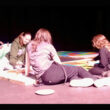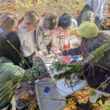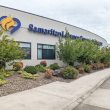The skies over River Bend Park gave Holley students a break from recent downpours during the last day of the annual Salmon Watch program, hosted by the South Santiam Watershed Council on Friday, Nov. 7.
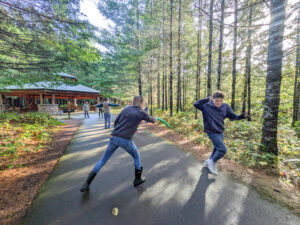
Though it was still a little chilly for the warm-blooded, white puffy clouds overhead parted some, revealing a sunny, light blue sky.
But the kids weren’t looking up.
Instead, they had their eyes on the ground, searching for bugs.
Angela Clegg, Sweet Home’s planning and building manager, was also there, breaking in a new pair of waders. Standing a bit off shore in the Santiam River, she attempted to scoop up macroinvertebrates with a net.
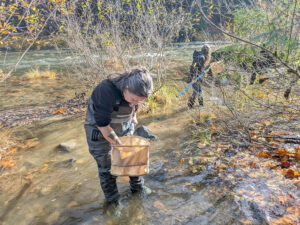
This was something of a treat for Clegg, who was involved in the beginnings of Salmon Watch for this area while she worked for both the Forest Service and South Santiam Watershed Council. She hadn’t participated in Salmon Watch since she began working for the city in 2018.
Until today.
She also got to tell the students about one of her favorite bugs, which she terms “the architects.”
Students gathered around a table where their captured macroinvertebrates were collected. Carly Rohn, an OSU student finishing up her degree in fish and wildlife this year, scooped a squirmy insect into a jar of water and brought it in closer to the kids’ faces.

It was a caddisfly larvae, an “architect.”
Clegg shared about the time she saw the caddisfly for the first time. It was in a fish tank, making a home out of precious stones. She later learned that caddisflies make casings around themselves with whatever they find in their environment – sand, rocks, grass, etc.
At another location in the park, a separate group of kids were involved in a cat and mouse activity. It wasn’t all just fun and games, though. They played games designed to help them learn.
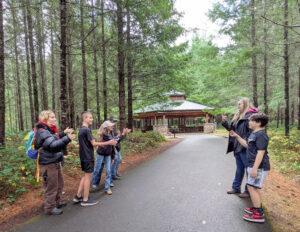
Adult instructors posing as bears and fishermen stood along a path. The kids, grouped as hatchery salmon and wild salmon, were tasked with going along the path “downstream” and migrating back up without being caught by one of their predators.
Meanwhile, a third group of kids took a nature walk. They were instructed to make observations from their senses as they learned about riparian habitats.
Salmon Watch usually includes a salmon dissection station, but this year they were unable to secure fish due to no available storage space for them.
Salmon Watch originated through the World Salmon Council, but the SSWC adapted the curriculum to better meet the needs for Sweet Home children, said Alex Shoulders, SSWC Watershed Education Coordinator.
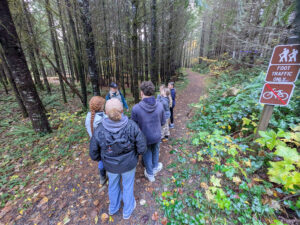
The program gives sixth graders a chance to spend a school day on the river where they can learn about salmon ecology, ecosystems, and its relation to humans.
The SSWC usually relies on volunteers to lead education stations every year, but they find it difficult to secure solid commitments, Shoulders said. This year, however, the watershed was able to obtain enough grant funding from the BottleDrop Fund to pay for Salmon Watch educators.
During lunch break, Clegg and Shoulders talked about funding and remarked about their desire to build up the Youth Watershed Council for high schoolers.
It’s a program often targeted for students in environmental science, forestry and agriculture classes, giving them an opportunity to do real restoration projects that matter, they said.

“There’s just not funding for that,” Clegg said. “And those are the students we should be focusing on, keeping that interest going.”
Funding is more easily found for educational programs aimed at younger students, Shoulders said.
In fact, Shoulders was among one of the first high school students to participate in the Youth Watershed Council when Clegg got the program started.
“It’s unfortunate, because we have all these great programs for the sixth graders and middle school area, but then we have that gap, and that’s where we want to try to catch the high school watershed team,” Clegg said.


